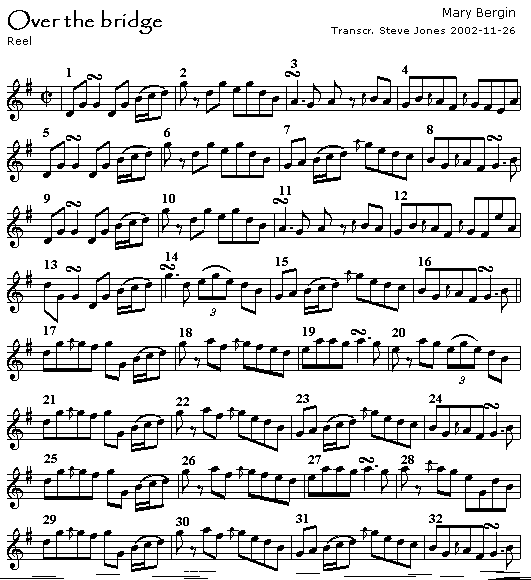Comments and transcription by Steve Jones, 26 November 2002

From a private recording circulating on the internet of Mary Bergin in concert. She plays two tunes in the set, the first of which, Over the bridge, is transcribed here. The second, The maid of Mt Cisco, features enthusiastic djembe accompaniment, which you are spared (for now).
This is an interesting example of Mary's playing because it's live and, unlike nearly everything on her solo CDs, has no accompaniment. The beauty of this is that we can more clearly hear how she uses her breath to add a splendid pulsing drive to the tune, much as a flute player would.
Over the bridge is a common-or-garden G reel consisting of standard licks and phrases arranged in a satisfying symmetrical structure. Peter Laban tells me the tune is known under other names, including The sailor's return and The rough road. We may as well stick with Mary's name for the tune, esp. since The sailor's return is another name for a completely different tune, Eileen Curran.
Mary plays the tune on a Eb whistle. She starts at a fine clip and you will notice that she speeds up as the tune progresses, perhaps due to slight nervousness in the concert setting. (Whatever the reason, those of us who resist the diktats of the "click-track and metronome brigade" can feel relief in the knowledge that even the gods and goddesses of ITM are prone to acceleration outside the studio.)
While I don't feel that this tune needs a bar-by-bar commentary, there are several features of interest. One is Mary's invariable use of the Bcd "triplet" (which I've notated in its true rhythm) to fill in all the instances of what would otherwise be a simple Bd eighth-note pair. (Look at the 3rd beat of bar 1, and then cast your eye down the page to see Mary's consistent use of this device, and the symmetrical nature of the tune. Incidentally, she is certainly playing a c#, but I chose not to clutter up the transcription by adding the accidental.)
What I enjoy most about this clip is the way Mary gets tremendous drive into the tune. This is not so much a result of the breakneck pace as of the articulation and pulse. Her use of cuts on strategic notes contributes greatly to the drive. I haven't attempted to mark tonguing or "diaphragmatic pushes", but if you listen attentively you'll hear these devices pervading the entire tune.
Notice also that Mary plays a long roll on the G at the end of every 8-bar section, keeping the momentum going by not taking a breath, but charging straight into the next phrase and breathing after the strong high g that starts the second bar of every phrase.
In bar 12 Mary pushes what would normally be a low E on the 4th beat up an octave. The following A stays in the first octave but another push sends the next note, D, up an octave to lead us into the final phrase of the first part. (You will notice the enthusiastic grunt of approval from a listener, who is obviously paying careful attention, and is delighted by this very nice little touch.) Mary continues her flourish with a slightly delayed long roll on the high g, instead of the usual quarter-note clipped to allow a breath.
The turn or second part features Mary swapping octaves again, this time dropping down. This is almost a trademark of her playing (and a feature which younger players such as Kathleen Coneely have seized upon and taken farther). In bar 17 (and all the bars that fall directly beneath it on the score) Mary splits what might ordinarily have been a quarter-note high g (or even a dotted quarter) in two, dropping down an octave for the second part. The Bcd triplet that follows can be seen as a decoration for the high d - a device Mary uses often.
Another octave drop occurs in bar 28. A variation is already under way with the use of a high a at the start of the bar (as opposed to the e in bar 20). The triplet on e used in the 3rd beat of bar 20 is replaced with a rocking figure which is given added interest by dropping the g.
The second playing matches the first very closely, with the exception of some variations in bars 27 and 28.
Clean, fast, classic Bergin playing that reminds us why Mary's 1981 debut solo album created such shock waves, putting the whistle's place as a serious instrument in Irish traditional music beyond all doubt.
Steve Jones, 27 November 2002